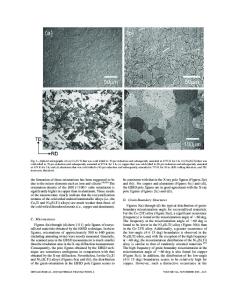Temperature Dependence of Yield Stress and Dislocation Dissociation in L1 2 -Ordered Intermetallic Compounds
- PDF / 465,428 Bytes
- 12 Pages / 432 x 648 pts Page_size
- 55 Downloads / 394 Views
Temperature Dependence of Yield Stress and Dislocation Dissociation in L12-Ordered Intermetallic Compounds Haruyuki Inui and Norihiko L. Okamoto Department of Materials Science and Engineering, Kyoto University Sakyo-ku, Kyoto 606-8501, Japan ABSTRACT The temperature dependence of yield stress and the associated dislocation dissociation in L12 intermetallic compounds are investigated in order to check the feasibility of the classification of L12 intermetallic compounds so far reported in terms of the planarity of core structures of partial dislocations with b = 1/2 and 1/3 on {111} and {001} glide planes. In contrast to what is believed from the reported classification, the motion of APB-coupled dislocations is proved to give rise to the rapid decrease in yield stress at low temperatures for Co3Ti and Co3 (Al,W). The temperature dependence of yield stress at low temperatures is newly interpreted in terms of a thermal component of solid-solution hardening, at least, for these two L12 compounds. We have proposed a new way to describe the yield stress–temperature curves of L12 compounds with three parameters (the athermal and thermal components of solid-solution hardening and the anomalous strengthening component) when the dislocation dissociation scheme is of the APB-type. INTRODUCTION Many intermetallic compounds such as TiAl have been investigated in the last two decades because of ever-increasing demands for structural materials that can withstand severe oxidizing environments and high operating temperatures [1]. The most widely used high-temperature structural materials in aircraft engines and power generation systems are at present Ni-base superalloys containing the L12-ordered intermetallic phase based on Ni3Al. Intermetallic compounds with the L12 structure such as Ni3Al are known to exhibit a yield stress anomaly, in which the yield stress anomalously increases with increasing temperature [2-4]. However, this peculiar mechanical property is not general for all L12 intermetallic compounds, and some of them are indeed reported not to exhibit a yield stress anomaly [5,6]. If we ignore those L12 compounds that exhibit an order-disorder transition, L12 intermetallic compounds are usually classified into three groups depending on their yield stress-temperature curves [7,8]. The first category includes those L12 compounds such as Ni3Al, in which a yield stress anomaly is observed from low temperatures such as liquid nitrogen temperature. For this class of alloy, dislocations are believed to dissociate into two collinear superpartials with b (Burgers vector) = 1/2 separated by an anti-phase boundary (APB). Cross slip of these superpartials from {111} to {001} is believed to be responsible for the yield stress anomaly. A rapid decrease in yield stress at high temperatures observed for these L12 compounds after the yield stress peak is believed to be due to thermally-activated glide of these superpartials on {001} planes. The second category includes those L12 compounds such as Pt3Al, in which the yield stress decreases
Data Loading...











